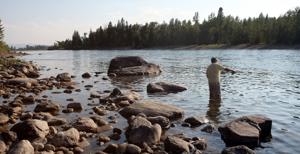Many Montana fishing guides follow ‘hoot owl’ hours, even in unrestricted streams

(The Center Square) – Rain over parts of Montana the past week and lower temperatures haven’t been enough to stop the state from putting fishing restrictions on its rivers.
Montana Fish, Wildlife and Parks added hoot owl fishing restrictions on Aug. 2 to 83 miles of the Bitterroot River and on a section of Fish on Aug. 3. Restrictions began on some rivers in mid-June. Abnormally high temperatures raised water temperatures, and drought conditions had been reducing streamflow.
The restrictions prohibit fishing between 2 p.m. and midnight.
The agency’s policy is to limit fishing when water temperatures exceed 73 degrees for three consecutive days. The water temperature must stay below 70 degrees for three consecutive days or the fishing restrictions will stay in place on the river until Sept. 15.
“It’s pretty much affecting everybody everywhere… and when I say that, I mean like from Craig to West Yellowstone,” Mike Bias, executive director of the Fishing Outfitters Association of Montana, told The Center Square.
He said outfitters support closures and restrictions on rivers to reduce pressure on trout mortality caused by anglers. If they sacrifice a bit this season and fish survive into next year with better stream flows, those sacrifices will benefit them next year, he said.
“With the restrictions, not all the rivers have gotten to the official point of having restrictions. But most guides at least that I know are doing their best to abide by hoot owl, even in streams where we don’t have hoot owl officially,” Bill Pfeiffer, outreach coordinator for Montana Trout Unlimited, told The Center Square.
The prolonged impact of hot, dry summers will have a negative impact on the industry if Montana is unable to continue improving its habitat and the amount of cold water in its streams, he said.
To solve these problems, representatives of all interested groups need a seat at the table, Pfeiffer said.
Montana Trout Unlimited does many things to improve habitat including stream restoration. That has an impact on water temperature as a properly restored trout stream doesn’t warm as quickly and it is a better habitat and better refuge for fish to survive these extreme conditions, he said. The organization wants more drought management plans for watersheds and updates to existing plans.
Anglers can help by using a net when fishing to help trout survive, Bias said.
“The quicker you get that fish into the net and released, the better his chances are for surviving that event,” Bias said.
Bring a thermometer as well, he advised. If the water temperature is above 67 degrees, it’s probably too warm for fishing. Even if the river is not restricted, stick to the hoot owl times when temperatures approach those critical levels for fish.
Pfeiffer said Montana Trout Unlimited is working with Fish, Game and Wildlife and the Fish and Game Commission. The organization has heard from anglers, outfitters and biologists, many of whom say 73 degrees for an upper river temperature limit is pretty high and should be lowered. Biologists also want more flexibility in hoot owl regulations to enable the protection of fisheries.
Anglers need to watch how and where they release fish. Tossing a fish into a backwater that has slow-moving water with no oxygen doesn’t do the fish any good. It goes to the bottom and suffocates.
“Don’t just dump them off the side of the boat and think they’re gonna swim away,” Bias said.
Some clients are calling to see if they should reschedule trips to later in the year when it’s cooler, he said.
Pfeiffer said Montanans can help streams by joining Trout Unlimited. The state has 13 different local chapters.
“And they are all doing some sort of good work, whether it’s educating young people or locating stream restoration projects in their local area that they can work on,” he said.
Sometime this fall Pfeiffer said to expect to see the formation of a Montana Wild Native Trout Coalition, which will be open to anyone concerned about Montana’s rivers and streams and wild trout management.
Montana has not stocked trout in any of its free-flowing rivers since 1974, an achievement in managing streams for wild reproduction that some residents might take for granted. The coalition would plan to increase awareness and support good policy so that it continues.
“And drought management is part of that, without a doubt,” Pfeiffer said.
Disclaimer: This content is distributed by The Center Square

